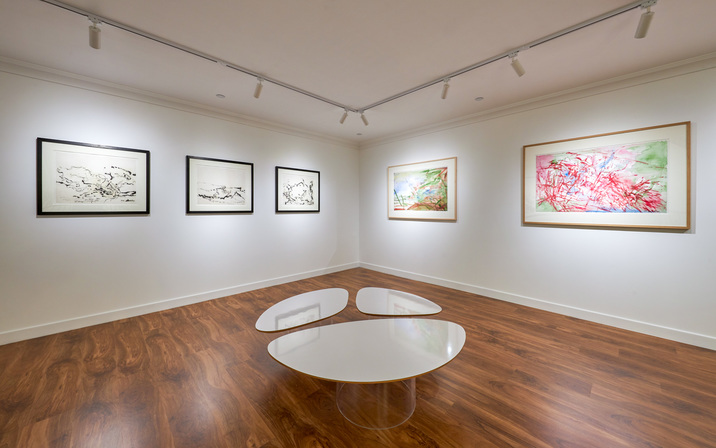-
From Current Issue
-
- Editor’s Letter Fire in the Heart
- Reviews I Gusti Ayu Kadek Murniasih
- Reviews 11th Seoul Mediacity Biennale: “One Escape at a Time”
- Dispatch Networked China
- One on One Monira Al Qadiri on Yukio Mishima
- Essays The rise of independent art spaces in pandemic-era Shanghai
- Features Tuan Andrew Nguyen
- Table of Contents
- Web Exclusives
- Archive
- Subscribe

R
E
V N
E
X
T
Installation view of ZAO WOU-KI’s “Friendship and Reconciliation” at Villepin, Hong Kong, 2020. All images courtesy Villepin.
Zao Wou-ki’s exhibition at Hong Kong’s newly opened Villepin gallery was less a retrospective than an alternative view of the modern master’s illustrious career. Informed by the late Franco-Chinese artist’s relationship with the Villepin family, “Friendship and Reconciliation” profiled the changes not only in Zao’s practice but also in his personal life.
A pair of early oil canvases at the entrance, Sans Titre (Juillet 1948) and Sans Titre (Sacré-Coeur) (both 1948), provided an intriguing comparison. While both are more representational than his later abstractions, they differ in essence. Juillet 1948 is a lively waterscape of Hangzhou, where the artist trained at the China Academy of Art. Detailed with stems of blooming lotus, with the faint outlines of a pavilion in the distance, the peach-washed composition recalls traditional Chinese bird-and-flower ink paintings. Sacré-Coeur, on the other hand, depicts the Parisian Basilica in bolder hues more akin to Fauvist palettes, with the blackened structure of the church offering a stark contrast to the bright red background. Painted when he first arrived in the French capital, the pair of works represent a duo state of symbiosis and contradiction between the East and the West, much like Zao himself.
Close by, Sans Titre (Funérailles) (1949) shows an inkling of his later abstractions, known for their undefined sense of space. A shadowy figure grasping the hands of a child rendered in outline trails behind a funeral carriage, dwarfed by the towering trees in their path. Zao painted over much of the surrounding landscape, submerging it in a sorrowful sea of turquoise. Two small red flags mark the end of the procession, but perhaps also ominously convey the start of another journey, into the afterlife.
While the paintings on the first floor showcased Zao’s evolving style, the second floor—of inks and watercolors—emphasized his meditative process. Originally trained in classical Chinese calligraphy, Zao did not return to the medium until 1971, following the illness and eventual suicide of his second wife, Chan May-Kan. He made several trips to China in the ensuing decades, and regularly practiced calligraphy. The Untitled trio (all 2005) on view exemplify his innovative approach to the traditional form, with spontaneous and emotionally charged brushstrokes that contrast with the finely rendered glyphs of his earlier “Oracle Bone” canvases, inspired by ancient script. The near-illegible texts of his Untitled works appear as abstracted mountainous landscapes and carry a sense of lightness, both visually and emotionally. Next to these, three untitled watercolors awash in soft translucent pinks, greens, and blues capture the brightness of the sceneries he saw at Quebec (2007), Gaudigny (2007), and La Cavalerie (2008). Painted during a temporary loss of inspiration, the en plein air works evince a yearning to revitalize.
The third floor showed some of Zao’s monumental works. In 07.05.2002 (2002), an imposing tower of dark smoke extends the entire length of the canvas, from the ground to the sky. A majestically distressing scene painted shortly after the artist suffered a bout of ill health, the canvas is also eerily reminiscent of the calamity of September 11 from the year prior. Yet despite the impression of anguish, the pale blue background is serene, signalling perseverance. Hommage à Françoise – 23.10.2003 (2003), in contrast, is a lusciously colorful composition. A tribute to Zao’s third wife, Françoise Marquet, the triptych renders the transition of their relationship from its initial passion to steady devotion over the three decades they spent together: the dominating wash of luminous red gradually gives way to a diffusion of subtle purple.
Tucked away in the corner of the third floor, in a dimly lit room, was a hidden gem. Mounted on deep navy walls was a collage of Zao’s sketches, some of them gestural studies completed when he first moved to France. Among these was a rare self-portrait, originally concealed as it was drawn on the back of one of his framed illustrations. Rendered in pencil in simple lines, the younger Zao appears composed and deep in thought. Touches like these humanized the artist at the exhibition, removing the grandeur that surrounds him as a coveted market favorite and restoring a sense of who he was: a dedicated and introspective artist.
Lauren Long is ArtAsiaPacific’s news and web editor.
Zao Wou-ki’s “Friendship & Reconciliation” is on view at Villepin, Hong Kong, until September 20, 2020.
To read more of ArtAsiaPacific’s articles, visit our Digital Library.



















